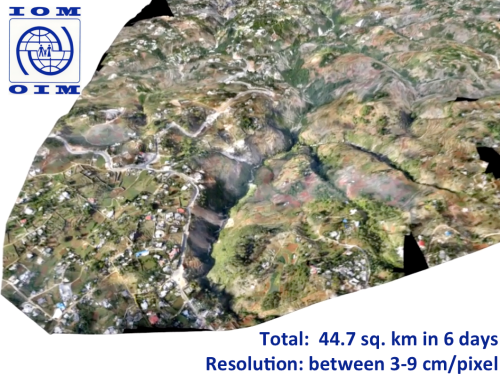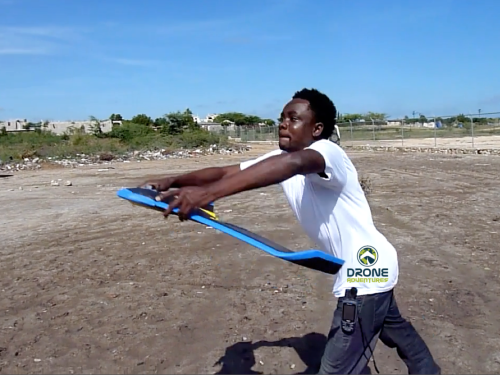Kristin Bergtora, who directs the Norwegian Center for Humanitarian Studies (and sits on the Advisory Board of the Humanitarian UAV Network, UAViators), just co-authored this important study on the growing role of UAVs or drones in the humanitarian space. Kristin and fellow co-author Kjersti Lohne consider the mainstreaming of UAVs as a technology-transfer from the global battlefield. “Just as drones have rapidly become intrinsic to modern warfare, it appears that they will increasingly find their place as part of the humanitarian governance apparatus.” The co-authors highlight the opportunities that drones offer for humanitarian assistance and explore how the notion of the humanitarian UAV will change humanitarian practices.
Kristin and Kjersti are particularly interested in two types of discourse around the use of UAVs in humanitarian settings. The first relates to the technical and logistical functions that UAVs might potentially fulfill as humanitarian functions. The second relates to the discourse around ethical uses of UAVs. The co-authors “analyze these two types of discourse” along with “their broader implications for humanitarian action.” The co-authors make the following two assumptions prior to carrying out there analysis. First, technologies change the balance of power (institutional power). Second, “although UAV technology may still be relatively primitive, it will evolve and proliferate as a technological paradigm.” To this end, the authors assume that the use of UAVs will “permeate the humanitarian field, and that the drones will be operated not only by states or intergovernmental actors, but also by NGOs.”
The study recognizes that the concept of the “humanitarian drone” is a useful one for military vendors who are urgently looking for other markets given continuing cuts in the US defense budget. “As the UAV industry tries to influence regulators and politicians […] by promoting the UAV as a humanitarian technology,” the co-authors warn that the humanitarian enterprise “risks becoming an important co-constructor of the UAV industry’s moral-economy narrative.” They stress the need for more research on the political economy of the humanitarian UAV.
That being said, while defense contractors are promoting their large surveillance drones for use in humanitarian settings, “a different group of actors—who might be seen as a new breed of ‘techie humanitarians’—have entered the race. Their aim is to develop small drones to conduct SAR [search and rescue] or to provide data about emergencies, as part of the growing field of crisis mapping.” This “micro-UAV” space is the one promoted by the Humanitarian UAV Network (UAViators), not only for imaging but for multi-sensing and payload delivery. Indeed, as “the functions of UAV technologies evolve from relief-site monitoring to carrying cargo, enabling UAVs to participate more directly in field operations, ‘civil UAV technologies will be able to aid considerably in human relief […].”

As UAVs continue collecting more information on disasters and the impact of humanitarian assistance, they will “part of the ongoing humanitarian challenge of securing, making sense of and maintaining Big Data, as well as developing processes for leveraging credible and actionable information in a reasonable amount of time. At the same time, the humanitarian enterprise is gradually becoming concerned about the privacy implications of surveillance, and the possible costs of witnessing.” This an area that the Humanitarian UAV Network is very much concerned about, so I hope that Kristen will continue to push for this given that she is also on the Advisory Board of UAViators.
In conclusion, the authors believe that the “focus on weaponized drones fails to capture the transformative potential of humanitarian drones and their possible impact on humanitarian action, and the associated pitfalls.” They also emphasize that “the notion of the humanitarian drone is still an immature concept, forming around an immature technology. It is unclear whether the integration of drones into humanitarian action will be cost-effective, ethical or feasible.” I agree with this but only in part since Kristin and Kjersti do not include small or micro-UAVs in their study. The latter are already being integrated in a cost-effective & ethical manner, which is in line with the Humanitarian UAV Network’s mission.

More research is needed on the role of small-UAVs in the humanitarian space and in particular on the new actors deploying them: from citizen journalists and local, grassroots communities to international humanitarian organizations & national NGOs. Another area ripe for research is the resulting “Big Data” that is likely to be generated by these new data collection technologies.
See Also:
- Humanitarians in the Sky: Using UAVs for Disaster Response [link]
- How UAVs are Making a Difference in Disaster Response [link]
- Humanitarians Using UAVs for Post Disaster Recovery [link]
- Grassroots UAVs for Disaster Response [link]
- Using UAVs for Search & Rescue [link]
- Debrief: UAV/Drone Search & Rescue Challenge [link]
- Crowdsourcing Analysis of UAV Imagery for Search/Rescue [link]
- Check-List for Flying UAVs in Humanitarian Settings [link]



Well done. Many in the defense industry are just realizing the immense value of tech transfer, dual use technologies for a broadening landscape of applications. Despite the challenges, there is great promise for these systems to do good for society.
Pingback: Reflections on the Use of UAVs in Humanitarian Interventions | iRevolution